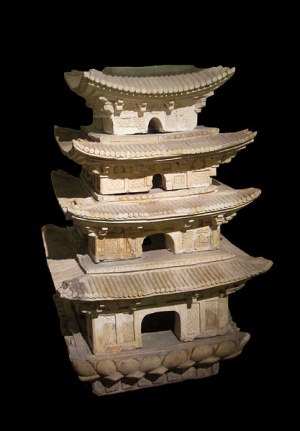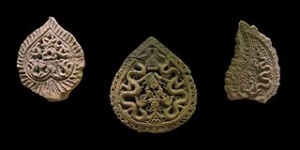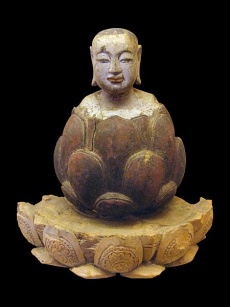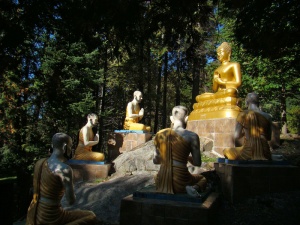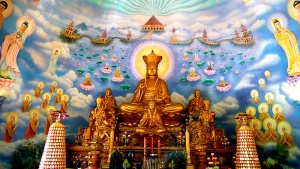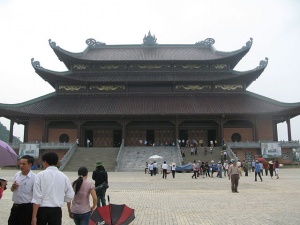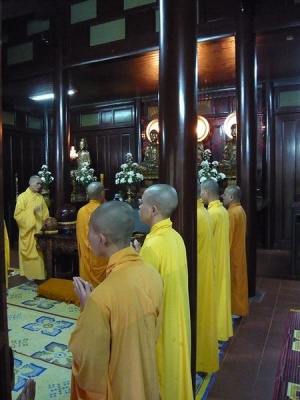Difference between revisions of "Buddhism in Vietnam"
(Created page with "thumb|Statue of [[Avalokiteshvara Bodhisattva, crimson and gilded wood, Restored Lê dynasty, autumn of Bính Thân...") |
|||
| Line 1: | Line 1: | ||
| − | [[File:La statue de Quan Am dans la pagode But Thap 2.jpg|thumb|Statue of [[Avalokiteshvara]] Bodhisattva, crimson and gilded wood, Restored Lê dynasty, autumn of Bính Thân year (1656).]] | + | [[File:La statue de Quan Am dans la pagode But Thap 2.jpg|thumb|Statue of [[Avalokiteshvara]] [[Bodhisattva]], crimson and gilded [[wood]], Restored Lê {{Wiki|dynasty}}, autumn of Bính Thân year (1656).]] |
| − | '''Buddhism in Vietnam''' (Vietnamese: Phật giáo) as practiced by the ethnic Vietnamese is mainly of the [[Mahāyāna]] tradition. [[Buddhism]] came to Vietnam as early as the 3rd or 2nd century BC from South Asia. Vietnamese Buddhism has had a symbiotic relationship with {{Wiki|Taoism}}, Chinese spirituality, and the indigenous Vietnamese religion. | + | '''[[Buddhism]] in [[Vietnam]]''' ([[Vietnamese]]: [[Phật]] giáo) as practiced by the {{Wiki|ethnic}} [[Vietnamese]] is mainly of the [[Mahāyāna]] [[tradition]]. [[Buddhism]] came to [[Vietnam]] as early as the 3rd or 2nd century BC from {{Wiki|South Asia}}. [[Vietnamese Buddhism]] has had a symbiotic relationship with {{Wiki|Taoism}}, {{Wiki|Chinese}} [[spirituality]], and the indigenous [[Vietnamese]] [[religion]]. |
==History== | ==History== | ||
===Dynastic period=== | ===Dynastic period=== | ||
| − | [[File:National Museum Vietnamese History 47 (cropped).jpg|thumb|left|Ceramic [[stupa]] with [[lotus]], bodhi leaf, dancer decoration, Hanoi (Lý dynasty, 11th-13th century)]] | + | [[File:National Museum Vietnamese History 47 (cropped).jpg|thumb|left|Ceramic [[stupa]] with [[lotus]], [[bodhi]] leaf, dancer decoration, {{Wiki|Hanoi}} (Lý {{Wiki|dynasty}}, 11th-13th century)]] |
[[File:National Museum Vietnamese History 37 (cropped).jpg|thumb|left|Terracotta Bodhi leaves with dragon motif (Lý-Trần dynasties, 11th-14th century)]] | [[File:National Museum Vietnamese History 37 (cropped).jpg|thumb|left|Terracotta Bodhi leaves with dragon motif (Lý-Trần dynasties, 11th-14th century)]] | ||
| − | Around 300 BC, proselytizing Buddhist delegations were sent from India, some of whom are thought to have reached Văn Lang (as Vietnam was known at the time). Another research concluded that [[Buddhism]] came to {{Wiki|Vietnam}} in the 1st or 2nd century AD through the North from central Asia and China and via the South from India trade routes. By the end of the 2nd century, Vietnam developed a major Buddhist center (probably [[Mahayana]]) in the region, commonly known as the {{Wiki|Luy Lâu}} center, now in the {{Wiki|Bắc Ninh}} province, north of the present day capital city of Hanoi. Luy Lâu was the capital of Giao Chỉ, (the former name of Vietnam), and was a popular place visited by many Indian Buddhist missionary monks to China. The monks followed the sea route from the Indian sub-continent to China used by Indian traders. A number of [[Mahayana sutras]] and the [[Agama]]s were translated into Chinese script at that center, including the [[Sutra of Forty-Two Chapters]] and the [[Anapanasati]]. | + | Around 300 BC, proselytizing [[Buddhist]] delegations were sent from [[India]], some of whom are [[thought]] to have reached Văn Lang (as [[Vietnam]] was known at the time). Another research concluded that [[Buddhism]] came to {{Wiki|Vietnam}} in the 1st or 2nd century AD through the [[North]] from central {{Wiki|Asia}} and [[China]] and via the [[South]] from [[India]] trade routes. By the end of the 2nd century, [[Vietnam]] developed a major [[Buddhist]] center (probably [[Mahayana]]) in the region, commonly known as the {{Wiki|Luy Lâu}} center, now in the {{Wiki|Bắc Ninh}} province, [[north]] of the {{Wiki|present}} day {{Wiki|capital city}} of {{Wiki|Hanoi}}. Luy Lâu was the capital of Giao Chỉ, (the former [[name]] of [[Vietnam]]), and was a popular place visited by many [[Indian]] [[Buddhist]] {{Wiki|missionary}} [[monks]] to [[China]]. The [[monks]] followed the sea route from the [[Indian]] sub-continent to [[China]] used by [[Indian]] traders. A number of [[Mahayana sutras]] and the [[Agama]]s were translated into {{Wiki|Chinese}} script at that center, including the [[Sutra of Forty-Two Chapters]] and the [[Anapanasati]]. |
| − | Over the next eighteen centuries Vietnam and China shared many common features of cultural, philosophical and religious heritage. This was due to geographical proximity to one another and Vietnam being annexed twice by the Chinese. Vietnamese Buddhism is closely related to [[Chinese Buddhism]] in general, and to some extent reflects the formation of Chinese Buddhism after the Song Dynasty. [[Theravada]] Buddhism would become incorporated through the annexation of the Khmer land and Khmer people. | + | Over the next eighteen centuries [[Vietnam]] and [[China]] shared many common features of {{Wiki|cultural}}, [[philosophical]] and [[religious]] heritage. This was due to geographical proximity to one another and [[Vietnam]] being annexed twice by the {{Wiki|Chinese}}. [[Vietnamese Buddhism]] is closely related to [[Chinese Buddhism]] in general, and to some extent reflects the formation of [[Chinese Buddhism]] after the {{Wiki|Song Dynasty}}. [[Theravada]] [[Buddhism]] would become incorporated through the annexation of the {{Wiki|Khmer}} land and {{Wiki|Khmer}} [[people]]. |
[[File:National Museum Vietnamese History 35 (cropped).jpg|thumb|upright|The boy Buddha rising up from lotus. Crimson and gilded wood, Trần-Hồ dynasty, Vietnam, 14th-15th century]] | [[File:National Museum Vietnamese History 35 (cropped).jpg|thumb|upright|The boy Buddha rising up from lotus. Crimson and gilded wood, Trần-Hồ dynasty, Vietnam, 14th-15th century]] | ||
| − | During the {{Wiki|Đinh Dynasty}} (968-980) [[Buddhism]] was recognized by the state as an official religion (~971) suggesting that the current kings at the time held Buddhism in high regard. The {{Wiki|Early Lê Dynasty}} (980-1009) would follow a similar path. Reasons for growth of Buddhism during this time is contributed to an influx of educated [[monks]], a newly independent state needing an ideological basis on which to build a country and the development of {{Wiki|Confucianism}}. | + | During the {{Wiki|Đinh Dynasty}} (968-980) [[Buddhism]] was [[recognized]] by the [[state]] as an official [[religion]] (~971) suggesting that the current [[kings]] at the time held [[Buddhism]] in high regard. The {{Wiki|Early Lê Dynasty}} (980-1009) would follow a similar [[path]]. [[Reasons]] for growth of [[Buddhism]] during this time is contributed to an [[influx]] of educated [[monks]], a newly {{Wiki|independent}} [[state]] needing an {{Wiki|ideological}} basis on which [[to build]] a country and the [[development]] of {{Wiki|Confucianism}}. |
| − | [[Buddhism]] became more prominent during the {{Wiki|Lý Dynasty}} (1009–1225) beginning with the founder {{Wiki|Lý Thái Tổ}} who was raised in a [[pagoda]] (Buddhist temple). All of the kings during the Ly Dynasty supported [[Buddhism]] as a state religion and this continued into the {{Wiki|Trần Dynasty}} (1225–1400) where [[Buddhism]] later developed in combination with {{Wiki|Confucianism}}. Buddhism fell out of favor during the {{Wiki|Later Lê Dynasty}}, for example {{Wiki|Lê Quát}}, but would grow under the {{Wiki|Nguyễn Dynasty}}. | + | [[Buddhism]] became more prominent during the {{Wiki|Lý Dynasty}} (1009–1225) beginning with the founder {{Wiki|Lý Thái Tổ}} who was raised in a [[pagoda]] ([[Buddhist temple]]). All of the [[kings]] during the Ly Dynasty supported [[Buddhism]] as a [[state]] [[religion]] and this continued into the {{Wiki|Trần Dynasty}} (1225–1400) where [[Buddhism]] later developed in combination with {{Wiki|Confucianism}}. [[Buddhism]] fell out of favor during the {{Wiki|Later Lê Dynasty}}, for example {{Wiki|Lê Quát}}, but would grow under the {{Wiki|Nguyễn Dynasty}}. |
| − | A Buddhist revival (Chan Hung Phat Giao) started in 1920 in an effort to reform and develop institutional Buddhism, which continues today. | + | A [[Buddhist]] revival ([[Chan]] Hung [[Phat]] Giao) started in 1920 in an [[effort]] to reform and develop institutional [[Buddhism]], which continues today. |
===Republican period=== | ===Republican period=== | ||
| − | [[File:Venerable Thích Quảng Đức Monument where he performed his self-immolation.JPG|thumb|Monument to [[Thích Quảng Đức]], who burned himself to death in 1963 in protest against the persecution of Buddhists by South Vietnam's Ngô Đình Diệm administration]] | + | [[File:Venerable Thích Quảng Đức Monument where he performed his self-immolation.JPG|thumb|Monument to [[Thích Quảng Đức]], who burned himself to [[death]] in 1963 in protest against the persecution of [[Buddhists]] by [[South]] Vietnam's Ngô Đình Diệm administration]] |
{{Seealso|Buddhist crisis|Huế Phật Đản shootings|Huế chemical attacks|Xá Lợi Pagoda raids}} | {{Seealso|Buddhist crisis|Huế Phật Đản shootings|Huế chemical attacks|Xá Lợi Pagoda raids}} | ||
| − | From 1954 to 1975, Vietnam was split into North and South Vietnam. In a country where surveys of the religious composition estimated the Buddhist majority to be approximately 86.5 percent, President Ngo Dinh Diem's policies generated claims of religious bias. As a member of the Catholic Vietnamese minority, he pursued pro-Catholic policies that antagonized many Buddhists. | + | From 1954 to 1975, [[Vietnam]] was split into [[North]] and {{Wiki|South Vietnam}}. In a country where surveys of the [[religious]] composition estimated the [[Buddhist]] majority to be approximately 86.5 percent, President Ngo [[Dinh]] Diem's policies generated claims of [[religious]] bias. As a member of the {{Wiki|Catholic}} [[Vietnamese]] minority, he pursued pro-Catholic policies that antagonized many [[Buddhists]]. |
| − | In May 1963, in the central city of Huế, where Diem's elder brother Ngo Dinh Thuc was the archbishop, Buddhists were prohibited from displaying Buddhist flags during [[Vesak]] celebrations. A few days earlier, Catholics were allowed to fly religious flags at a celebration in honour of Thuc. This led to a protest against the government, which was suppressed by Diem's forces, killing nine civilians. This led to a mass campaign against Diem's government during the [[Buddhist crisis]]. Notably, [[Thich Quang Duc]] self-immolated and later Diem's younger brother Ngo Dinh Nhu ordered the special forces to raid [[pagoda]]s across the country, killing an estimated hundreds. After this, the US government withdrew support and Diem and his family were deposed and killed. | + | In May 1963, in the central city of Huế, where Diem's elder brother Ngo [[Dinh]] Thuc was the [[archbishop]], [[Buddhists]] were prohibited from displaying [[Buddhist]] flags during [[Vesak]] {{Wiki|celebrations}}. A few days earlier, [[Catholics]] were allowed to fly [[religious]] flags at a celebration in honour of Thuc. This led to a protest against the government, which was suppressed by Diem's forces, {{Wiki|killing}} nine civilians. This led to a {{Wiki|mass}} campaign against Diem's government during the [[Buddhist crisis]]. Notably, [[Thich Quang Duc]] self-immolated and later Diem's younger brother Ngo [[Dinh]] Nhu ordered the special forces to raid [[pagoda]]s across the country, {{Wiki|killing}} an estimated hundreds. After this, the US government withdrew support and Diem and his family were deposed and killed. |
| − | Under Communist rule, many religious practices in Vietnam including [[Buddhism]] were suppressed. However a government sanctioned and approved United Buddhist Church was created in the North. In the South, The [[Unified Buddhist Church]] was created and opposed the communist government. Since Đổi Mới (1986) many reforms have allowed [[Buddhism]] to be practiced further. It was not until 2007 that [[Pure Land]] Buddhism, the most widespread type of [[Buddhism]] practiced in Vietnam, was officially recognized as a religion by the government. | + | Under [[Communist]] {{Wiki|rule}}, many [[religious]] practices in [[Vietnam]] including [[Buddhism]] were suppressed. However a government sanctioned and approved United [[Buddhist]] {{Wiki|Church}} was created in the [[North]]. In the [[South]], The [[Unified Buddhist Church]] was created and opposed the [[communist]] government. Since Đổi Mới (1986) many reforms have allowed [[Buddhism]] to be practiced further. It was not until 2007 that [[Pure Land]] [[Buddhism]], the most widespread type of [[Buddhism]] practiced in [[Vietnam]], was officially [[recognized]] as a [[religion]] by the government. |
| − | Today, Buddhists are located almost everywhere in Vietnam (From North to South). Buddhism is the single largest religion in Vietnam, with between 9% to 16% of the population identifying themselves as Buddhist. | + | Today, [[Buddhists]] are located almost everywhere in [[Vietnam]] (From [[North]] to [[South]]). [[Buddhism]] is the single largest [[religion]] in [[Vietnam]], with between 9% to 16% of the population identifying themselves as [[Buddhist]]. |
===Overseas=== | ===Overseas=== | ||
[[File:QC Harrington4 tango7174.jpg|thumb|upright=1|Buddhist Monastery of Tam Bao Son, Harrington, Quebec, Canada]] | [[File:QC Harrington4 tango7174.jpg|thumb|upright=1|Buddhist Monastery of Tam Bao Son, Harrington, Quebec, Canada]] | ||
| − | After the fall of South Vietnam to communism in 1975 at the end of the Vietnam War, the first major Buddhist community appeared in North America. Since this time the North American Vietnamese Buddhist community has grown to 160 temples and centers. Proselytizing is not a priority. | + | After the fall of {{Wiki|South Vietnam}} to {{Wiki|communism}} in 1975 at the end of the [[Vietnam]] [[War]], the first major [[Buddhist]] {{Wiki|community}} appeared in [[North America]]. Since this time the [[North]] American [[Vietnamese]] [[Buddhist]] {{Wiki|community}} has grown to 160 [[temples]] and centers. Proselytizing is not a priority. |
| − | The most famous practitioner of synchronized Thiền Buddhism in the West is [[Thích Nhất Hạnh]] who has authored dozens of books and founded [[Dharma]] center [[Plum Village]] in France together with his colleague, [[Bhiksuni]] and [[Zen]] Master [[Chân Không]]. According to Nguyen and Barber, [[Thich Nhat Hanh]]’s fame in the Western world as a proponent of engaged Buddhism and a new zen style has “no affinity with or any foundation in traditional Vietnamese Buddhist | + | The most famous [[practitioner]] of synchronized Thiền [[Buddhism in the West]] is [[Thích Nhất Hạnh]] who has authored dozens of [[books]] and founded [[Dharma]] center [[Plum Village]] in {{Wiki|France}} together with his colleague, [[Bhiksuni]] and [[Zen]] [[Master]] [[Chân Không]]. According to Nguyen and Barber, [[Thich Nhat Hanh]]’s [[fame]] in the {{Wiki|Western}} [[world]] as a proponent of engaged [[Buddhism]] and a new [[zen]] style has “no [[affinity]] with or any foundation in [[traditional]] [[Vietnamese]] [[Buddhist practices]]” and according to Alexander Soucy (2007) his style of [[Zen]] [[Buddhism]] is not reflective of actual [[Vietnamese Buddhism]]. (Yet [[Thích]] Nhất Hạnh often recounts about his early [[Zen]] practices in [[Vietnam]] in his [[Dharma]] talks saying that he continued and developed this practice in the [[West]] which has a {{Wiki|distinctive}} [[Vietnamese]] [[Thien]] {{Wiki|flavor}}.) |
| − | Thich Nhat Hanh’s Buddhist teachings have started to return to a Vietnam where the Buddhist landscape is now being shaped by the combined Vietnamese & Westernized Buddhism that is focused more on the [[meditative]] practices. | + | Thich Nhat Hanh’s [[Buddhist teachings]] have started to return to a [[Vietnam]] where the [[Buddhist]] landscape is now being shaped by the combined [[Vietnamese]] & Westernized [[Buddhism]] that is focused more on the [[meditative]] practices. |
==Practice== | ==Practice== | ||
[[Image:Ksitigarbha Statue Mural Vietnam.jpeg|thumb|right|Vietnamese art of the [[pure land]] of [[Ksitigarbha|Kṣitigarbha]] [[Bodhisattva]].]] | [[Image:Ksitigarbha Statue Mural Vietnam.jpeg|thumb|right|Vietnamese art of the [[pure land]] of [[Ksitigarbha|Kṣitigarbha]] [[Bodhisattva]].]] | ||
| − | Followers in Vietnam practice differing traditions without any problem or sense of contradiction. Few Vietnamese Buddhists would identify themselves as a particular kind of [[Buddhism]], as a Christian might identify him or herself by a denomination, for example. Although Vietnamese Buddhism does not have a strong centralized structure, the practice is similar throughout the country at almost any [[temple]]. | + | Followers in [[Vietnam]] practice differing [[traditions]] without any problem or [[sense]] of {{Wiki|contradiction}}. Few [[Vietnamese]] [[Buddhists]] would identify themselves as a particular kind of [[Buddhism]], as a [[Christian]] might identify him or herself by a denomination, for example. Although [[Vietnamese Buddhism]] does not have a strong centralized {{Wiki|structure}}, the practice is similar throughout the country at almost any [[temple]]. |
| − | Gaining [[merit]] is the most common and essential practice in Vietnamese Buddhism with a belief that liberation takes place with the help of [[Buddhas]] and [[bodhisattvas]]. Buddhist monks commonly chant [[sutra]]s, recite | + | Gaining [[merit]] is the most common and [[essential]] practice in [[Vietnamese Buddhism]] with a [[belief]] that [[liberation]] takes place with the help of [[Buddhas]] and [[bodhisattvas]]. [[Buddhist]] [[monks]] commonly [[chant]] [[sutra]]s, recite [[Buddhas]]’ names ([[Amitabha]] most notably, doing repentance and praying for [[rebirth]] in the [[Pure Land]]). |
| − | The [[Lotus Sutra]] and [[Amitabha Sutra]] are the most commonly used [[sutras]]. Most sutras and texts have come from China and have been translated into Sino-Vietnamese (Han –Viet) rather than the vernacular making them largely incomprehensible to most practitioners. | + | The [[Lotus Sutra]] and [[Amitabha Sutra]] are the most commonly used [[sutras]]. Most [[sutras]] and texts have come from [[China]] and have been translated into Sino-Vietnamese (Han –Viet) rather than the {{Wiki|vernacular}} making them largely incomprehensible to most practitioners. |
| − | Three services are practiced regularly at dawn, noon, and dusk. They include sutras (mainly devotional), reciting [[dharani]]s and Buddha’s name, and circumambulation (walking [[meditation]]). [[Laypeople]] at times join the services at the [[temple]] and some devout Buddhist practice the services at home. Special services such as Sam Nguyen / Sam Hoi (confession / repentance) takes place on the full moon and new moon each month. Chanting the name of Buddha is one way of repenting and purifying bad [[karma]]. | + | Three services are practiced regularly at dawn, noon, and dusk. They include [[sutras]] (mainly devotional), reciting [[dharani]]s and [[Buddha’s]] [[name]], and circumambulation (walking [[meditation]]). [[Laypeople]] at times join the services at the [[temple]] and some devout [[Buddhist practice]] the services at home. Special services such as Sam Nguyen / Sam Hoi ({{Wiki|confession}} / repentance) takes place on the [[full moon]] and [[new moon]] each month. [[Chanting]] the [[name]] of [[Buddha]] is one way of repenting and purifying bad [[karma]]. |
==Branches== | ==Branches== | ||
| − | ===Mahāyāna traditions=== | + | ===[[Mahāyāna]] [[traditions]]=== |
[[Image:BaiDinh Dien TamThe.JPG|thumb|Bái Đính Temple in Ninh Bình Province]] | [[Image:BaiDinh Dien TamThe.JPG|thumb|Bái Đính Temple in Ninh Bình Province]] | ||
[[Image:Buddhist Monk Service Hue Vietnam.jpeg|thumb|Monks holding a service in Huế.]] | [[Image:Buddhist Monk Service Hue Vietnam.jpeg|thumb|Monks holding a service in Huế.]] | ||
| − | The overall doctrinal position of Vietnamese Buddhism is the inclusive system of [[Tiantai]], with the higher metaphysics informed by the [[Huayan school|Huayan]] tradition; however, the orientation of Vietnamese Buddhism is syncretic without making such distinctions. Therefore, modern practice of Vietnamese Buddhism can be very eclectic, including elements from [[Zen]], [[Pure Land]], [[Tiantai]], and popular practices from [[Vajrayana|Esoteric Buddhism]]. According to Charles Prebish, many English language sources contain misconceptions regarding the variety of doctrines and practices in traditional Vietnamese Buddhism: | + | The overall [[doctrinal]] position of [[Vietnamese Buddhism]] is the inclusive system of [[Tiantai]], with the higher [[metaphysics]] informed by the [[Huayan school|Huayan]] [[tradition]]; however, the orientation of [[Vietnamese Buddhism]] is {{Wiki|syncretic}} without making such {{Wiki|distinctions}}. Therefore, {{Wiki|modern}} practice of [[Vietnamese Buddhism]] can be very eclectic, including [[elements]] from [[Zen]], [[Pure Land]], [[Tiantai]], and popular practices from [[Vajrayana|Esoteric Buddhism]]. According to Charles Prebish, many English [[language]] sources contain misconceptions regarding the variety of [[doctrines]] and practices in [[traditional]] [[Vietnamese Buddhism]]: |
| − | : We will not consider here the misconceptions presented in most English-language materials regarding the distinctness of these schools, and the strong inclination for "syncretism" found in Chinese and Vietnamese Buddhism. Much has been said about the incompatibility of different schools and their difficulty in successfully communicating with each other and combining their doctrines. None of these theories reflects realities in Vietnam (or China) past or present. The followers have no problem practicing the various teachings at the same time. | + | : We will not consider here the misconceptions presented in most English-language materials regarding the distinctness of these schools, and the strong inclination for "[[syncretism]]" found in {{Wiki|Chinese}} and [[Vietnamese Buddhism]]. Much has been said about the incompatibility of different schools and their difficulty in successfully communicating with each other and combining their [[doctrines]]. None of these theories reflects [[realities]] in [[Vietnam]] (or [[China]]) {{Wiki|past}} or {{Wiki|present}}. The followers have no problem practicing the various teachings at the same time. |
| − | The methods of [[Pure Land]] Buddhism are perhaps the most widespread within Vietnam. It is common for practitioners to recite [[sutra]]s, [[chant]]s and [[dharani]]s looking to gain protection through [[bodhisattvas]] or [[Dharma-Protectors]]. It is a devotional practice where those practicing put their faith into [[Amitabha]] Buddha (V. A Di Đà Phật). Followers believe they will gain rebirth in the [[Pure Land]] by chanting [[Amitabha]]’s name. The [[Pure Land]] is where one can more easily gain [[enlightenment]] since [[suffering]] does not exist. Many religious organizations have not been recognized by the government however in 2007, with 1.5 million followers, The [[Vietnamese Pure Land Buddhism Association]] (Tịnh Độ Cư Sĩ Phật Hội Việt Nam ) received official recognition as an independent and legal religious organization. | + | The methods of [[Pure Land]] [[Buddhism]] are perhaps the most widespread within [[Vietnam]]. It is common for practitioners to recite [[sutra]]s, [[chant]]s and [[dharani]]s looking to gain [[protection]] through [[bodhisattvas]] or [[Dharma-Protectors]]. It is a devotional practice where those practicing put their [[faith]] into [[Amitabha]] [[Buddha]] (V. A Di Đà [[Phật]]). Followers believe they will gain [[rebirth]] in the [[Pure Land]] by [[chanting]] [[Amitabha]]’s [[name]]. The [[Pure Land]] is where one can more easily gain [[enlightenment]] since [[suffering]] does not [[exist]]. Many [[religious]] organizations have not been [[recognized]] by the government however in 2007, with 1.5 million followers, The [[Vietnamese Pure Land Buddhism Association]] (Tịnh Độ Cư Sĩ [[Phật]] Hội Việt Nam ) received official {{Wiki|recognition}} as an {{Wiki|independent}} and legal [[religious]] organization. |
| − | Thiền is the Vietnamese name for the school of [[Zen]] Buddhism. Thiền Tông, or the "[[Zen]] school", is derived from the Chinese [[Chan]]-zong, in which Chan derivatives of the Sanskrit "[[Dhyāna]]". The traditional account is that in 580 CE, an Indian monk named [[Vinitaruci]] (Vietnamese: Tì-ni-đa-lưu-chi) traveled to Vietnam after completing his studies with [[Jianzhi Sengcan]], the third patriarch of [[Chinese Zen]]. This would be the first appearance of Vietnamese Zen, or Thien (thiền) Buddhism. The sect that Vinitaruci and his lone Vietnamese disciple founded would become known as the oldest branch of Thien. After a period of obscurity, the [[Vinitaruci School]] became one of the most influential Buddhist groups in Vietnam by the 10th century, particularly under the patriarch [[Vạn-Hạnh]] (died 1018). Other early Vietnamese Zen schools included the [[Vo Ngon Thong]] (Vô Ngôn Thông), which was associated with the teaching of Mazu, and the [[Thao Duong]] (Thảo Đường), which incorporated nianfo chanting techniques; both were founded by Chinese monks. | + | Thiền is the [[Vietnamese]] [[name]] for the school of [[Zen]] [[Buddhism]]. Thiền Tông, or the "[[Zen]] school", is derived from the {{Wiki|Chinese}} [[Chan]]-zong, in which [[Chan]] derivatives of the [[Sanskrit]] "[[Dhyāna]]". The [[traditional]] account is that in 580 CE, an [[Indian]] [[monk]] named [[Vinitaruci]] ([[Vietnamese]]: Tì-ni-đa-lưu-chi) traveled to [[Vietnam]] after completing his studies with [[Jianzhi Sengcan]], the [[third patriarch]] of [[Chinese Zen]]. This would be the first [[appearance]] of [[Vietnamese]] [[Zen]], or [[Thien]] (thiền) [[Buddhism]]. The [[sect]] that [[Vinitaruci]] and his lone [[Vietnamese]] [[disciple]] founded would become known as the oldest branch of [[Thien]]. After a period of {{Wiki|obscurity}}, the [[Vinitaruci School]] became one of the most influential [[Buddhist]] groups in [[Vietnam]] by the 10th century, particularly under the [[patriarch]] [[Vạn-Hạnh]] ([[died]] 1018). Other early [[Vietnamese]] [[Zen]] schools included the [[Vo Ngon Thong]] (Vô Ngôn Thông), which was associated with the [[teaching]] of [[Mazu]], and the [[Thao Duong]] (Thảo Đường), which incorporated [[nianfo]] [[chanting]] techniques; both were founded by {{Wiki|Chinese}} [[monks]]. |
| − | A new Thiền school was founded by King {{Wiki|Trần Nhân Tông}} (1258–1308); called [[Trúc Lâm]] (Bamboo Grove) school, which evinced a deep influence from Confucian and Taoist philosophy. Nevertheless, Trúc Lâm's prestige waned over the following centuries as Confucianism became dominant in the royal court. In the 17th century, a group of Chinese monks led by [[Nguyên Thiều]] introduced the [[Ling school]] ( Lâm Tế). A more domesticated offshoot of [[Lâm Tế]], the [[Liễu Quán school]], was founded in the 18th century and has since been the predominant branch of [[Vietnamese Zen]]. | + | A new Thiền school was founded by [[King]] {{Wiki|Trần Nhân Tông}} (1258–1308); called [[Trúc Lâm]] ([[Bamboo Grove]]) school, which evinced a deep influence from [[Wikipedia:Confucianism|Confucian]] and [[Wikipedia:Taoism|Taoist]] [[philosophy]]. Nevertheless, Trúc Lâm's prestige waned over the following centuries as [[Wikipedia:Confucianism|Confucianism]] became dominant in the {{Wiki|royal court}}. In the 17th century, a group of {{Wiki|Chinese}} [[monks]] led by [[Nguyên Thiều]] introduced the [[Ling school]] ( Lâm Tế). A more domesticated offshoot of [[Lâm Tế]], the [[Liễu Quán school]], was founded in the 18th century and has since been the predominant branch of [[Vietnamese Zen]]. |
| − | Some scholars argue that the importance and prevalence of [[Zen]] ([[Thiền]]) in Vietnam has been greatly overstated and that [[Zen]] has played more of an elite rhetorical role than a role of practice. The Thiền Uyển Tập Anh (Outstanding Figures in the Vietnamese Zen Community) has been the dominant text used to legitimize the Zen Buddhist lineage and history within Vietnam. However Cuong Tu Nguyen’s | + | Some [[scholars]] argue that the importance and prevalence of [[Zen]] ([[Thiền]]) in [[Vietnam]] has been greatly overstated and that [[Zen]] has played more of an {{Wiki|elite}} [[Wikipedia:Rhetoric|rhetorical]] role than a role of practice. The Thiền Uyển Tập Anh (Outstanding Figures in the [[Vietnamese]] [[Zen]] {{Wiki|Community}}) has been the dominant text used to legitimize the [[Zen]] [[Buddhist]] [[lineage]] and history within [[Vietnam]]. However Cuong Tu Nguyen’s “[[Zen]] in {{Wiki|Medieval}} [[Vietnam]]: A Study and Translation of the [[Thien]] Tap Anh” (1997) gives a critical review of how the text has been used to create a history of [[Zen Buddhism]] that that is “fraught with [[Wikipedia:Discontinuity(Postmodernism),|discontinuity]]”. Current day [[Buddhist practices]] are not reflective of a [[Zen]] {{Wiki|past}} is that in {{Wiki|modern}} day [[Vietnam]] the common practices are more focused on [[ritual]] and [[devotion]] than the [[Zen]] focus on [[meditation]]. Nonetheless, we are [[seeing]] an increased population in [[Zen]] today. Two figures who have been responsible for this increased [[interest]] in [[Thien]] is [[Thich Nhat Hanh]], currently residing in {{Wiki|France}}, and [[Thich Thanh Tu]], who [[lives]] in Da Lat. |
| − | ===Theravada=== | + | ===[[Theravada]]=== |
[[Image:VietnamChampa1.gif|thumb|South East Asia circa 1010 AD, Dai Viet (Vietnamese) lands in yellow.]] | [[Image:VietnamChampa1.gif|thumb|South East Asia circa 1010 AD, Dai Viet (Vietnamese) lands in yellow.]] | ||
| − | The central and southern part of present day Vietnam were originally inhabited by the Cham people and the Khmer people respectively who followed both a syncretic Saiva-Mahayana (see [[History of Buddhism in Cambodia]]) Buddhism and [[Theravada]] Buddhism. The Đại Việt (Vietnamese) annexed the land occupied by the Cham during conquests in the 15th century, and by the 18th century had also annexed the southern portion of the {{Wiki|Khmer Empire}}, resulting in the current borders of Vietnam. From that time onward, the dominant Đại Việt (Vietnamese) followed the [[Mahayana]] tradition while the Khmer continued to practice [[Theravada]]. | + | The central and southern part of {{Wiki|present}} day [[Vietnam]] were originally inhabited by the [[Cham]] [[people]] and the {{Wiki|Khmer}} [[people]] respectively who followed both a {{Wiki|syncretic}} Saiva-Mahayana (see [[History of Buddhism in Cambodia]]) [[Buddhism]] and [[Theravada]] [[Buddhism]]. The Đại Việt ([[Vietnamese]]) annexed the land occupied by the [[Cham]] during conquests in the 15th century, and by the 18th century had also annexed the southern portion of the {{Wiki|Khmer Empire}}, resulting in the current borders of [[Vietnam]]. From that time onward, the dominant Đại Việt ([[Vietnamese]]) followed the [[Mahayana]] [[tradition]] while the {{Wiki|Khmer}} continued to practice [[Theravada]]. |
| − | In the 1920s and 1930s, there were a number of movements in Vietnam for the revival and modernization of Buddhist activities. Together with the re-organization of [[Mahayana]] establishments, there developed a growing interest in [[Theravadin]] [[meditation]] as well as the [[Pali Canon]]. These were then available in French. Among the pioneers who brought [[Theravada]] Buddhism to the ethnic Đại Việt was a young veterinary doctor named Lê Văn Giảng. He was born in the South, received higher education in Hanoi, and after graduation, was sent to Phnom Penh, Cambodia, to work for the French government. | + | In the 1920s and 1930s, there were a number of movements in [[Vietnam]] for the revival and modernization of [[Buddhist]] [[activities]]. Together with the re-organization of [[Mahayana]] establishments, there developed a growing [[interest]] in [[Theravadin]] [[meditation]] as well as the [[Pali Canon]]. These were then available in {{Wiki|French}}. Among the pioneers who brought [[Theravada]] [[Buddhism]] to the {{Wiki|ethnic}} Đại Việt was a young veterinary doctor named Lê Văn Giảng. He was born in the [[South]], received higher [[education]] in {{Wiki|Hanoi}}, and after graduation, was sent to {{Wiki|Phnom Penh}}, [[Cambodia]], to work for the {{Wiki|French}} government. |
| − | During that time he became especially interested in [[Theravada]] Buddhist practice. Subsequently, he decided to ordain and took the [[Dhamma]] name of Hộ-Tông (Vansarakkhita). In 1940, upon an invitation from a group of lay Buddhists led by Mr. Nguyễn Văn Hiểu, he went back to Vietnam in order to help establish the first Theravada temple for Vietnamese Buddhists, at Gò Dưa, Thủ Đức (now a district of Hồ Chí Minh City). The temple was named Bửu Quang (Ratana Ramsyarama). The temple was destroyed by French troops in 1947, and was later rebuilt in 1951. At [[Bửu Quang temple]], together with a group of Vietnamese [[bhikkhu]]s (monks), who had received training in Cambodia, such as Venerables [[Thiện Luật]], [[Bửu Chơn]], [[Kim Quang]] and [[Giới Nghiêm]], [[Venerable Hộ Tông]] began teaching the [[Dhamma]] in their native Vietnamese. He also translated many Buddhist materials from the [[Pali Canon]], and [[Theravada]] became part of Vietnamese Buddhist activity in the country. | + | During that time he became especially [[interested]] in [[Theravada]] [[Buddhist practice]]. Subsequently, he decided to ordain and took the [[Dhamma]] [[name]] of Hộ-Tông (Vansarakkhita). In 1940, upon an invitation from a group of lay [[Buddhists]] led by Mr. Nguyễn Văn Hiểu, he went back to [[Vietnam]] in order to help establish the first [[Theravada]] [[temple]] for [[Vietnamese]] [[Buddhists]], at Gò Dưa, Thủ Đức (now a district of Hồ Chí Minh City). The [[temple]] was named Bửu Quang ([[Ratana]] Ramsyarama). The [[temple]] was destroyed by {{Wiki|French}} troops in 1947, and was later rebuilt in 1951. At [[Bửu Quang temple]], together with a group of [[Vietnamese]] [[bhikkhu]]s ([[monks]]), who had received {{Wiki|training}} in [[Cambodia]], such as [[Venerables]] [[Thiện Luật]], [[Bửu Chơn]], [[Kim Quang]] and [[Giới Nghiêm]], [[Venerable Hộ Tông]] began [[teaching]] the [[Dhamma]] in their native [[Vietnamese]]. He also translated many [[Buddhist]] materials from the [[Pali Canon]], and [[Theravada]] became part of [[Vietnamese]] [[Buddhist]] [[activity]] in the country. |
| − | In 1949–1950, Venerable Hộ Tông together with Mr Nguyễn Văn Hiểu and supporters built a new temple in Saigon (now Hồ Chí Minh City), named Kỳ Viên Tự (Jetavana Vihara). This temple became the centre of [[Theravada]] activities in Vietnam, which continued to attract increasing interest among the Vietnamese Buddhists. In 1957, the Vietnamese Theravada Buddhist Sangha Congregation (Giáo Hội Tăng Già Nguyên Thủy Việt Nam) was formally established and recognised by the government, and the Theravada [[Sangha]] elected Venerable Hộ Tông as its first President, or Sangharaja. | + | In 1949–1950, [[Venerable]] Hộ Tông together with Mr Nguyễn Văn Hiểu and supporters built a new [[temple]] in Saigon (now Hồ Chí Minh City), named Kỳ Viên Tự ([[Jetavana Vihara]]). This [[temple]] became the centre of [[Theravada]] [[activities]] in [[Vietnam]], which continued to attract increasing [[interest]] among the [[Vietnamese]] [[Buddhists]]. In 1957, the [[Vietnamese Theravada Buddhist Sangha Congregation]] (Giáo Hội Tăng Già Nguyên Thủy Việt Nam) was formally established and recognised by the government, and the [[Theravada]] [[Sangha]] elected [[Venerable]] Hộ Tông as its first President, or [[Sangharaja]]. |
| − | From Saigon, the Theravada movement spread to other provinces, and soon, a number of Theravada temples for ethnic Viet Buddhists were established in many areas in the South and Central parts of Vietnam. As of 1997, there were 64 Theravada temples throughout the country, of which 19 were located in Hồ Chí Minh City and its vicinity. Besides Bửu Quang and Kỳ Viên temples, other well known temples are Bửu Long, Giác Quang, Tam Bảo (Đà Nẵng), Thiền Lâm and Huyền Không (Huế), and the large Sakyamuni Buddha Monument ([[Thích Ca Phật Đài]]) in Vũng Tàu. | + | From Saigon, the [[Theravada]] {{Wiki|movement}} spread to other provinces, and soon, a number of [[Theravada]] [[temples]] for {{Wiki|ethnic}} Viet [[Buddhists]] were established in many areas in the [[South]] and Central parts of [[Vietnam]]. As of 1997, there were 64 [[Theravada]] [[temples]] throughout the country, of which 19 were located in Hồ Chí Minh City and its vicinity. Besides Bửu Quang and Kỳ Viên [[temples]], other well known [[temples]] are Bửu Long, Giác Quang, Tam Bảo (Đà Nẵng), Thiền Lâm and Huyền Không (Huế), and the large [[Sakyamuni Buddha]] Monument ([[Thích Ca Phật Đài]]) in Vũng Tàu. |
{{W}} | {{W}} | ||
[[Category:Vietnam]] | [[Category:Vietnam]] | ||
Latest revision as of 16:28, 5 February 2015
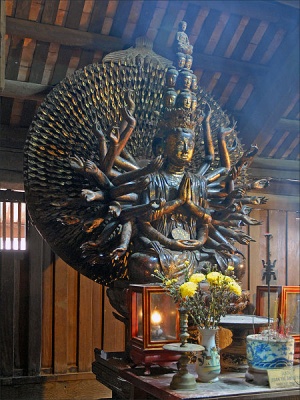
Buddhism in Vietnam (Vietnamese: Phật giáo) as practiced by the ethnic Vietnamese is mainly of the Mahāyāna tradition. Buddhism came to Vietnam as early as the 3rd or 2nd century BC from South Asia. Vietnamese Buddhism has had a symbiotic relationship with Taoism, Chinese spirituality, and the indigenous Vietnamese religion.
History
Dynastic period
Around 300 BC, proselytizing Buddhist delegations were sent from India, some of whom are thought to have reached Văn Lang (as Vietnam was known at the time). Another research concluded that Buddhism came to Vietnam in the 1st or 2nd century AD through the North from central Asia and China and via the South from India trade routes. By the end of the 2nd century, Vietnam developed a major Buddhist center (probably Mahayana) in the region, commonly known as the Luy Lâu center, now in the Bắc Ninh province, north of the present day capital city of Hanoi. Luy Lâu was the capital of Giao Chỉ, (the former name of Vietnam), and was a popular place visited by many Indian Buddhist missionary monks to China. The monks followed the sea route from the Indian sub-continent to China used by Indian traders. A number of Mahayana sutras and the Agamas were translated into Chinese script at that center, including the Sutra of Forty-Two Chapters and the Anapanasati.
Over the next eighteen centuries Vietnam and China shared many common features of cultural, philosophical and religious heritage. This was due to geographical proximity to one another and Vietnam being annexed twice by the Chinese. Vietnamese Buddhism is closely related to Chinese Buddhism in general, and to some extent reflects the formation of Chinese Buddhism after the Song Dynasty. Theravada Buddhism would become incorporated through the annexation of the Khmer land and Khmer people.
During the Đinh Dynasty (968-980) Buddhism was recognized by the state as an official religion (~971) suggesting that the current kings at the time held Buddhism in high regard. The Early Lê Dynasty (980-1009) would follow a similar path. Reasons for growth of Buddhism during this time is contributed to an influx of educated monks, a newly independent state needing an ideological basis on which to build a country and the development of Confucianism.
Buddhism became more prominent during the Lý Dynasty (1009–1225) beginning with the founder Lý Thái Tổ who was raised in a pagoda (Buddhist temple). All of the kings during the Ly Dynasty supported Buddhism as a state religion and this continued into the Trần Dynasty (1225–1400) where Buddhism later developed in combination with Confucianism. Buddhism fell out of favor during the Later Lê Dynasty, for example Lê Quát, but would grow under the Nguyễn Dynasty.
A Buddhist revival (Chan Hung Phat Giao) started in 1920 in an effort to reform and develop institutional Buddhism, which continues today.
Republican period
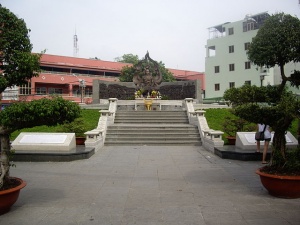
- See also :
- See also :
From 1954 to 1975, Vietnam was split into North and South Vietnam. In a country where surveys of the religious composition estimated the Buddhist majority to be approximately 86.5 percent, President Ngo Dinh Diem's policies generated claims of religious bias. As a member of the Catholic Vietnamese minority, he pursued pro-Catholic policies that antagonized many Buddhists.
In May 1963, in the central city of Huế, where Diem's elder brother Ngo Dinh Thuc was the archbishop, Buddhists were prohibited from displaying Buddhist flags during Vesak celebrations. A few days earlier, Catholics were allowed to fly religious flags at a celebration in honour of Thuc. This led to a protest against the government, which was suppressed by Diem's forces, killing nine civilians. This led to a mass campaign against Diem's government during the Buddhist crisis. Notably, Thich Quang Duc self-immolated and later Diem's younger brother Ngo Dinh Nhu ordered the special forces to raid pagodas across the country, killing an estimated hundreds. After this, the US government withdrew support and Diem and his family were deposed and killed.
Under Communist rule, many religious practices in Vietnam including Buddhism were suppressed. However a government sanctioned and approved United Buddhist Church was created in the North. In the South, The Unified Buddhist Church was created and opposed the communist government. Since Đổi Mới (1986) many reforms have allowed Buddhism to be practiced further. It was not until 2007 that Pure Land Buddhism, the most widespread type of Buddhism practiced in Vietnam, was officially recognized as a religion by the government.
Today, Buddhists are located almost everywhere in Vietnam (From North to South). Buddhism is the single largest religion in Vietnam, with between 9% to 16% of the population identifying themselves as Buddhist.
Overseas
After the fall of South Vietnam to communism in 1975 at the end of the Vietnam War, the first major Buddhist community appeared in North America. Since this time the North American Vietnamese Buddhist community has grown to 160 temples and centers. Proselytizing is not a priority.
The most famous practitioner of synchronized Thiền Buddhism in the West is Thích Nhất Hạnh who has authored dozens of books and founded Dharma center Plum Village in France together with his colleague, Bhiksuni and Zen Master Chân Không. According to Nguyen and Barber, Thich Nhat Hanh’s fame in the Western world as a proponent of engaged Buddhism and a new zen style has “no affinity with or any foundation in traditional Vietnamese Buddhist practices” and according to Alexander Soucy (2007) his style of Zen Buddhism is not reflective of actual Vietnamese Buddhism. (Yet Thích Nhất Hạnh often recounts about his early Zen practices in Vietnam in his Dharma talks saying that he continued and developed this practice in the West which has a distinctive Vietnamese Thien flavor.)
Thich Nhat Hanh’s Buddhist teachings have started to return to a Vietnam where the Buddhist landscape is now being shaped by the combined Vietnamese & Westernized Buddhism that is focused more on the meditative practices.
Practice
Followers in Vietnam practice differing traditions without any problem or sense of contradiction. Few Vietnamese Buddhists would identify themselves as a particular kind of Buddhism, as a Christian might identify him or herself by a denomination, for example. Although Vietnamese Buddhism does not have a strong centralized structure, the practice is similar throughout the country at almost any temple.
Gaining merit is the most common and essential practice in Vietnamese Buddhism with a belief that liberation takes place with the help of Buddhas and bodhisattvas. Buddhist monks commonly chant sutras, recite Buddhas’ names (Amitabha most notably, doing repentance and praying for rebirth in the Pure Land).
The Lotus Sutra and Amitabha Sutra are the most commonly used sutras. Most sutras and texts have come from China and have been translated into Sino-Vietnamese (Han –Viet) rather than the vernacular making them largely incomprehensible to most practitioners.
Three services are practiced regularly at dawn, noon, and dusk. They include sutras (mainly devotional), reciting dharanis and Buddha’s name, and circumambulation (walking meditation). Laypeople at times join the services at the temple and some devout Buddhist practice the services at home. Special services such as Sam Nguyen / Sam Hoi (confession / repentance) takes place on the full moon and new moon each month. Chanting the name of Buddha is one way of repenting and purifying bad karma.
Branches
Mahāyāna traditions
The overall doctrinal position of Vietnamese Buddhism is the inclusive system of Tiantai, with the higher metaphysics informed by the Huayan tradition; however, the orientation of Vietnamese Buddhism is syncretic without making such distinctions. Therefore, modern practice of Vietnamese Buddhism can be very eclectic, including elements from Zen, Pure Land, Tiantai, and popular practices from Esoteric Buddhism. According to Charles Prebish, many English language sources contain misconceptions regarding the variety of doctrines and practices in traditional Vietnamese Buddhism:
- We will not consider here the misconceptions presented in most English-language materials regarding the distinctness of these schools, and the strong inclination for "syncretism" found in Chinese and Vietnamese Buddhism. Much has been said about the incompatibility of different schools and their difficulty in successfully communicating with each other and combining their doctrines. None of these theories reflects realities in Vietnam (or China) past or present. The followers have no problem practicing the various teachings at the same time.
The methods of Pure Land Buddhism are perhaps the most widespread within Vietnam. It is common for practitioners to recite sutras, chants and dharanis looking to gain protection through bodhisattvas or Dharma-Protectors. It is a devotional practice where those practicing put their faith into Amitabha Buddha (V. A Di Đà Phật). Followers believe they will gain rebirth in the Pure Land by chanting Amitabha’s name. The Pure Land is where one can more easily gain enlightenment since suffering does not exist. Many religious organizations have not been recognized by the government however in 2007, with 1.5 million followers, The Vietnamese Pure Land Buddhism Association (Tịnh Độ Cư Sĩ Phật Hội Việt Nam ) received official recognition as an independent and legal religious organization.
Thiền is the Vietnamese name for the school of Zen Buddhism. Thiền Tông, or the "Zen school", is derived from the Chinese Chan-zong, in which Chan derivatives of the Sanskrit "Dhyāna". The traditional account is that in 580 CE, an Indian monk named Vinitaruci (Vietnamese: Tì-ni-đa-lưu-chi) traveled to Vietnam after completing his studies with Jianzhi Sengcan, the third patriarch of Chinese Zen. This would be the first appearance of Vietnamese Zen, or Thien (thiền) Buddhism. The sect that Vinitaruci and his lone Vietnamese disciple founded would become known as the oldest branch of Thien. After a period of obscurity, the Vinitaruci School became one of the most influential Buddhist groups in Vietnam by the 10th century, particularly under the patriarch Vạn-Hạnh (died 1018). Other early Vietnamese Zen schools included the Vo Ngon Thong (Vô Ngôn Thông), which was associated with the teaching of Mazu, and the Thao Duong (Thảo Đường), which incorporated nianfo chanting techniques; both were founded by Chinese monks.
A new Thiền school was founded by King Trần Nhân Tông (1258–1308); called Trúc Lâm (Bamboo Grove) school, which evinced a deep influence from Confucian and Taoist philosophy. Nevertheless, Trúc Lâm's prestige waned over the following centuries as Confucianism became dominant in the royal court. In the 17th century, a group of Chinese monks led by Nguyên Thiều introduced the Ling school ( Lâm Tế). A more domesticated offshoot of Lâm Tế, the Liễu Quán school, was founded in the 18th century and has since been the predominant branch of Vietnamese Zen.
Some scholars argue that the importance and prevalence of Zen (Thiền) in Vietnam has been greatly overstated and that Zen has played more of an elite rhetorical role than a role of practice. The Thiền Uyển Tập Anh (Outstanding Figures in the Vietnamese Zen Community) has been the dominant text used to legitimize the Zen Buddhist lineage and history within Vietnam. However Cuong Tu Nguyen’s “Zen in Medieval Vietnam: A Study and Translation of the Thien Tap Anh” (1997) gives a critical review of how the text has been used to create a history of Zen Buddhism that that is “fraught with discontinuity”. Current day Buddhist practices are not reflective of a Zen past is that in modern day Vietnam the common practices are more focused on ritual and devotion than the Zen focus on meditation. Nonetheless, we are seeing an increased population in Zen today. Two figures who have been responsible for this increased interest in Thien is Thich Nhat Hanh, currently residing in France, and Thich Thanh Tu, who lives in Da Lat.
Theravada
The central and southern part of present day Vietnam were originally inhabited by the Cham people and the Khmer people respectively who followed both a syncretic Saiva-Mahayana (see History of Buddhism in Cambodia) Buddhism and Theravada Buddhism. The Đại Việt (Vietnamese) annexed the land occupied by the Cham during conquests in the 15th century, and by the 18th century had also annexed the southern portion of the Khmer Empire, resulting in the current borders of Vietnam. From that time onward, the dominant Đại Việt (Vietnamese) followed the Mahayana tradition while the Khmer continued to practice Theravada.
In the 1920s and 1930s, there were a number of movements in Vietnam for the revival and modernization of Buddhist activities. Together with the re-organization of Mahayana establishments, there developed a growing interest in Theravadin meditation as well as the Pali Canon. These were then available in French. Among the pioneers who brought Theravada Buddhism to the ethnic Đại Việt was a young veterinary doctor named Lê Văn Giảng. He was born in the South, received higher education in Hanoi, and after graduation, was sent to Phnom Penh, Cambodia, to work for the French government.
During that time he became especially interested in Theravada Buddhist practice. Subsequently, he decided to ordain and took the Dhamma name of Hộ-Tông (Vansarakkhita). In 1940, upon an invitation from a group of lay Buddhists led by Mr. Nguyễn Văn Hiểu, he went back to Vietnam in order to help establish the first Theravada temple for Vietnamese Buddhists, at Gò Dưa, Thủ Đức (now a district of Hồ Chí Minh City). The temple was named Bửu Quang (Ratana Ramsyarama). The temple was destroyed by French troops in 1947, and was later rebuilt in 1951. At Bửu Quang temple, together with a group of Vietnamese bhikkhus (monks), who had received training in Cambodia, such as Venerables Thiện Luật, Bửu Chơn, Kim Quang and Giới Nghiêm, Venerable Hộ Tông began teaching the Dhamma in their native Vietnamese. He also translated many Buddhist materials from the Pali Canon, and Theravada became part of Vietnamese Buddhist activity in the country.
In 1949–1950, Venerable Hộ Tông together with Mr Nguyễn Văn Hiểu and supporters built a new temple in Saigon (now Hồ Chí Minh City), named Kỳ Viên Tự (Jetavana Vihara). This temple became the centre of Theravada activities in Vietnam, which continued to attract increasing interest among the Vietnamese Buddhists. In 1957, the Vietnamese Theravada Buddhist Sangha Congregation (Giáo Hội Tăng Già Nguyên Thủy Việt Nam) was formally established and recognised by the government, and the Theravada Sangha elected Venerable Hộ Tông as its first President, or Sangharaja.
From Saigon, the Theravada movement spread to other provinces, and soon, a number of Theravada temples for ethnic Viet Buddhists were established in many areas in the South and Central parts of Vietnam. As of 1997, there were 64 Theravada temples throughout the country, of which 19 were located in Hồ Chí Minh City and its vicinity. Besides Bửu Quang and Kỳ Viên temples, other well known temples are Bửu Long, Giác Quang, Tam Bảo (Đà Nẵng), Thiền Lâm and Huyền Không (Huế), and the large Sakyamuni Buddha Monument (Thích Ca Phật Đài) in Vũng Tàu.
